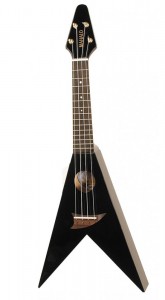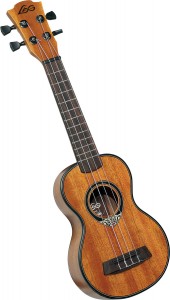Ukulele
In the fine tradition of traveling minstrels, a lot of interesting looking folks with musical instruments have been passing through our little town of Dominical, locally known as Dysfunction Junction. Some of them linger for a while, playing at a bonfire on the beach, or blissed out dancing at the Envision Festival or boogying at Best Fest, or sharing an original song with the fascinated locals at the bus stop. Most guitar manufacturers now routinely offer backpacker instruments for the musical traveler who doesn’t want to be laden down, but they are often pricey and frankly are not really close to being able to cope with the jungle stuff here that assaults wood and glue and metal. So, the coolest choice of instrument must surely be the humble yet powerful ukulele. I’ve seen lots of them lately – they are small and lightweight, inexpensive yet pretty darned durable, and they have this infectious happy quality that just makes people smile. And the nylon strings don’t hurt your fingers!
Most musical historians agree that the birth of the ukulele began in 1879, when farm workers from Portugal, the Madeira Islands and even Cape Verde arrived in the Hawaiian Islands aboard the English ship Ravenscrag and subsequent vessels. Some of these guys brought with them small guitar-like instruments called a machete, braguinha or the rajao, and other wooden instruments with cat-gut strings – the precursors to what we now call a ukulele. Many of these workers had a passion for working with wood, and so began a rich tradition of ukulele craftsmanship in Hawaii. In 1915 there was a Pan-Pacific International Expo held in San Francisco and the Hawaiian contingent, with their little ukes, were a big hit. America was inundated with Hawaiian themed songs and musicians, and the sheet music printed at the time even included the chord symbols for the ukulele, just as they do today with guitar chords. Vaudeville entertainers played them, college boys serenaded their girls with them and kids learned basic music on them. And manufacturing companies like Martin, Gibson, Harmony and Epiphone all worked overtime to meet the demand for these instruments.

Generally made out of wood, some ukes are composed partially or entirely from plastic or other materials – the cheaper ones out of ply or laminate, and the acoustically superior instruments from spruce or mahogany, with the most expensive made from a Hawaiian hardwood called Koa. They are usually of a figure 8 body shape, but sometimes come in a cutaway style, or an oval shape (called a pineapple uke), or a boat-paddle shape or even a square shape – often made from an old wooden cigar box. They mostly have four strings, but some styles have paired strings for a total of 6 or 8 strings. There are four sizes, which dictates the pitch, volume and tone – soprano, concert, tenor and baritone. Another odd characteristic is that in the most common tuning (my dog has fleas) the bottom string is not the lowest in pitch, as is the case with most wooden instruments.
In the so-called Jazz Age of American music the uke was used in many combos or as the favorite instrument to accompany the crooners of the day. Country music artists like Jimmie Rodgers played it, and it was featured in some of the old-timey kind of hillbilly bands popular back then – rarely has an instrument been used in so many musical formats! The Depression years of the 1930s and the war years of the 40s brought a temporary lapse of interest, but the uke hysteria began again in the 50s with the appearance of baritone uke player Arthur Godfrey, whose numerous TV and radio appearances helped put it back in the limelight. In the 60s, Tiny Tim’s novelty cover of the Nick Lucas tune “Tiptoe Through the Tulips” made a big splash and is still probably the best known uke song in the states. And what a weird spectacle he was to be the inspiration for a musical movement…. According to Queen Lili’uokalani, the last Hawaiian monarch, the name means ‘the gift that came from here’ – uku (gift or reward) and lele (to come). One of the reasons it got so established in Hawaiian music and culture was support from King Kalakaua, who was a patron of the arts and brought it into performances at royal gatherings. Apparently the name also roughly translates as ‘the jumping flea’ – a whimsical but pretty apt description.
There must be a bunch of 60-something folks up in Canada sitting around their warm fires drinking beer and playing ukuleles, because in the 60s a music educator named J. Chalmers Doane dramatically changed the school music programs across Canada by introducing the uke as an inexpensive and practical teaching instrument to foster musical literacy in the classroom. At the peak of the program some 50,000 kids and adults learned how to play the ukulele, and it is still a staple in many of the music courses there.
Today many established musicians have re-discovered the beauty of this instrument – George Harrison was a big fan of the uke, and was a major collector of the instrument, which both Sir Paul and John also played. Eddie Vedder, of the rock band Pearl Jam, has put out several solo albums featuring ukulele music and has re-introduced the instrument to a whole new generation. Check out this partial list of ukulele players past and present – Steven Tyler, Andy Griffith, Pete Townshend, Bruce Springsteen, Arlo Guthrie, Warren Buffett, Johnny Winter, astronaut Neil Armstrong, Elvis Presley, Don Henley, Jack Johnson, David Byrne, George Clooney, Lucille Ball, Taylor Swift and Peter Sellers. I can’t imagine anything else all those folks could have in common.
Ben Orton and I played a wedding recently where they requested the songs ‘Somewhere Over the Rainbow’ and ‘What a Wonderful World’ as played by the Hawaiian musician Israel Kamakawiwo’ole, better known as Bruddah Iz. Now those young folks didn’t have a clue who had originally performed those songs – they didn’t know who Judy Garland or Louis Armstrong was – but they were moved by Israel’s rendition of these beautiful songs. Truly it gives me goose bumps and a lump in my throat to see/hear this huge, gentle guy playing that little ukulele and singing so soulfully. Bruddah Iz formed the Makaha Sons of Ni’ihau when he was still a teen-ager, a band that blended contemporary styles with the traditional music of Hawaii. They released a dozen or so albums while together, and Bruddah Iz went on to record several solo albums, including “Facing Future”, which is still the all-time best selling album in Hawaii. He was a hero for promoting awareness of the second class status pushed onto the natives by the tourist industry, and the ‘Over the Rainbow’ medley reached #12 on the Billboard charts and has been used in countless films, TV shows and commercials. When he died in 1997 at age 38 thousands and thousands of Hawaiians and music lovers witnessed his family spreading his ashes in the waters of the Pacific in a traditional paddle-out ceremony to honor him, and flags throughout the islands were flown at half-mast. The power of a big heart and a little wooden ukulele.

Now there’s this precious cute young Hawaiian man on the ukulele scene who is re-inventing it once again as a relevant instrument. His name is Jake Shimabukuro, and he has been declared a musical ‘hero’ by Rolling Stone magazine and has been compared to Jimi Hendrix and Miles Davis. He has collaborated in the studio with legendary producer Alan Parsons (Pink Floyd’s ‘Dark Side of the Moon’) and his great video of George Harrison’s ‘While My Guitar Gently Weeps’ has gone viral. He and his fans are known as “Uke Nation”, and until you’ve heard his version of ‘Bohemian Rhapsody’ you ain’t heard nothin’ yet….
Without a doubt the coolest present I’ve received in ages is a ukulele – and not just any uke, but my husband Charley got me a shiny black Flying V shaped uke from the music store in San Isidro. I am looking forward to some hammock time with my uke during rainy season, and hopefully one of these Friday nights I’ll play it with Ben Jammin’ and the Howlers at our regular Friday night gig at Roca Verde in Dominical. Come on out and party with us – we have recently been playing with Quepos guitarist and bassist Arturo Campo Alcocer and Ojochal’s Tim Rath on drums, and it is rockin’ good! As always, thanks for supporting live music in our little part of the world!!
My favorite new story – A woman is at a ukulele festival with a lovely soprano uke under her arm. Another woman walks up and gazes admiringly at the first woman’s uke, at which point the woman holding the uke looks over and says with a smile, “I got it for my husband.” The second woman nods and says, “Good trade!”

